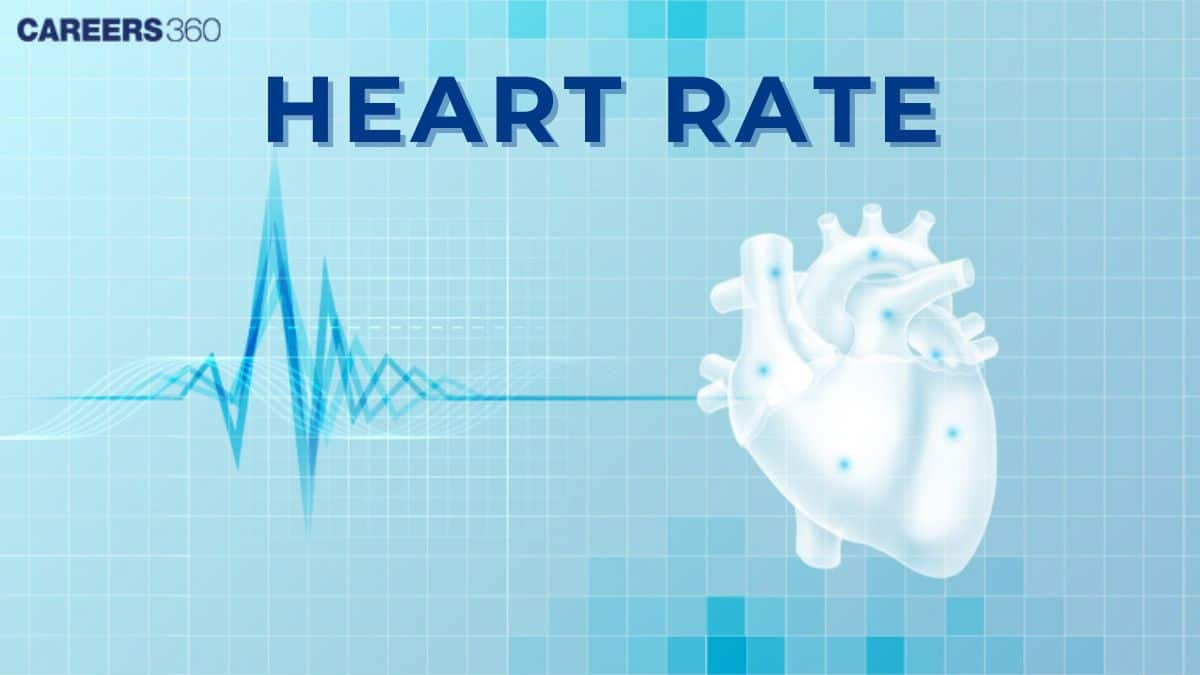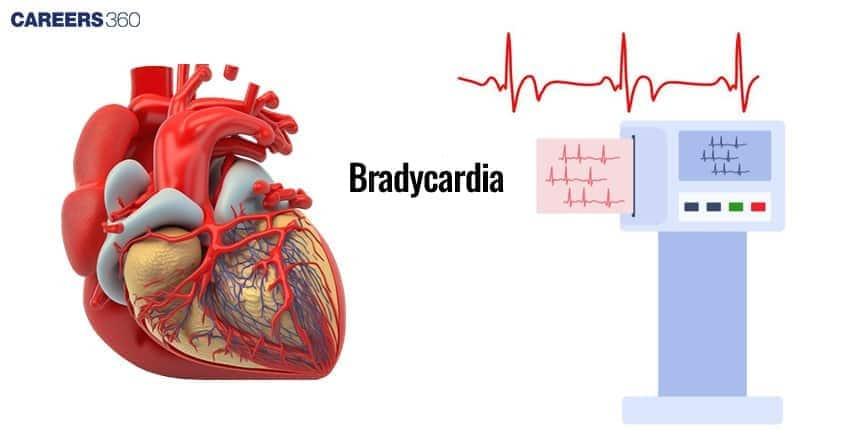Heart Rate: Definition, Bradycardia, Tachycardia
Heart rate refers to the number of times the heart beats per minute (bpm) and reflects the efficiency of cardiac function. It varies with age, fitness, and physiological state, helping detect conditions like bradycardia (slow rate) and tachycardia (fast rate). Monitoring heart rate supports early diagnosis and overall cardiovascular health.
This Story also Contains
- What is Heart Rate?
- Normal Heart Rate Range
- Factors Affecting Heart Rate
- Bradycardia – Low Heart Rate
- Tachycardia – High Heart Rate
- Bradycardia vs Tachycardia
- Role of Autonomic Nervous System in Heart Rate Control
- Why It's Important To Monitor Heart Rate
- Heart Rate NEET MCQs (With Answers & Explanations)
- Recommended video on Heart Rate

What is Heart Rate?
Heart rate is the clinical measure of heart health, denoting the proper functioning of your heart. Heart rate is an expression of how often your heart beats. It can be measured as the pulse at the wrist or the neck. There are numerous types of devices such as ECGs and heart rate monitors. Knowing what constitutes a normal heart rate and understanding conditions like bradycardia and tachycardia will help you maintain better cardiovascular health.
Normal Heart Rate Range
Heart rate is influenced by age. In adults, it ranges from 60 to 100 beats per minute. In kids, heart rates tend to be higher, which can be attributed to a faster metabolic rate and a smaller size of the heart. In athletes, a lower resting
Age Group | Normal Heart Rate (bpm) |
Newborns (0-1 year) | 100-160 |
Children (1-10 years) | 70-120 |
Adults (18+ years) | 60-100 |
Athletes | 40-60 |
Factors Affecting Heart Rate
Some of the other factors that account for abnormal rates of heartbeats include:
Age: Children have faster heart rate
Physical fitness: Athletes show lower resting heart rate
Stress and emotion: Increase heart rate via sympathetic nervous system
Temperature and humidity: Higher heart rate due to vasodilation
Medications: Medicines can either increase or decrease heart rate, for example beta blockers lower the heart rate while stimulants increase it
Bradycardia – Low Heart Rate
Bradycardia is when the rate is normally below 60 beats per minute in a resting heart. Bradycardia comes from a Greek word, “brady” meaning slow and “kardia” meaning “heart”
Symptoms
The common symptoms of bradycardia are:
Chest discomfort
Shortness of breath
Weakness and fatigue
Dizziness
Fainting spells
Causes
The causes of bradycardia are:
Damage t f the cardiac muscles
Aging or congenital defects in the heart
Hypothyroidism
Certain medications such as beta blockers and digoxin
Diagnosis
Bradycardia is diagnosed through tests such as an electrocardiogram (ECG), Holter monitor and exercise stress tests. If any structural abnormalities are suspected then an echocardiogram is performed.
Treatment
Treatment options include bradycardia medications and implantation of pacemaker in severe cases. Lifestyle modifications like regular exercise and avoiding smoking and alcohol also helps in managing the condition.

Tachycardia – High Heart Rate
The normal resting heart rate is above 100 bpm for adults. Thus, tachycardia is considered any heart rate that is more rapid than usual. It comes from a Greek word, “tachy” meaning “quick” and “kardia” meaning “heart”
Symptoms
The common symptoms in people experiencing tachycardia are:
Palpitations or rapid pulse
Dizziness
Shortness of breath
Chest pain
Anxiety
Fatigue
Causes
Tachycardia may be triggered by:
Heart disease like high blood pressure (hypertension), coronary artery disease
Smoking and alcohol
Fever and dehydration
Hyperthyroidism
Other stress like emotional or physical stress
Diagnosis
Diagnostic tests will be performed to rule out tachycardia. ECGs to detect abnormal rhythm and Holter monitors for 24 hour observation. Blood tests are also performed to check the levels of thyroid and electrolyte in the body.
Treatment
Tachycardia is treated with medications like beta blockers or calcium channel blockers. Cardioversion or ablation for arrhythmia and lifestyle modifications like stress control and avoiding smoking and alcohol are suggested.
Bradycardia vs Tachycardia
There are different symptoms and causes between bradycardia and tachycardia.
Feature | Bradycardia | Tachycardia |
Definition | Heart rate is less than 60 bpm | Heart rate is greater than 100 bpm |
Cause | A low rate is achieved by the parasympathetic system. | A high heart rate is achieved by the sympathetic system. |
Symptoms | Dizziness, fatigue | Palpitations, chest pain |
Risk | Heart block, low oxygen delivery | Arrhythmia, heart failure |
Treatment | Implantation of pacemaker | Bet blockers, ablation |
Role of Autonomic Nervous System in Heart Rate Control
The role of autonomic nervous system in heart rate control is:
The sympathetic nervous system (SNS) increases heart rate via the release of norepinephrine.
The parasympathetic nervous system (PNS) decreases heart rate via vagus nerve stimulation.
A balance between both sympathetic and parasympathetic nervous systems maintains homeostasis in the body.
Why It's Important To Monitor Heart Rate
Monitoring heart rate helps to detect early signs of health complications like arrhythmia, heart block, cardiovascular strain or metabolic issues like thyroid. Tools can be used to trace or monitor heart rate. For example smartwatch, fitness bands and smartphone apps that make it easier to keep a tab on heart conditions. Devices like ECG, pulse oximeter and medical heart rate monitors are more advanced and are useful in checking heart rate.
Heart Rate NEET MCQs (With Answers & Explanations)
Important topic for NEET are:
Bradycardia (symptoms, causes, treatment)
Tachycardia (symptoms, causes, treatment)
Bradycardia vs Tachycardia
Practice Questions for NEET
Q1. Hormonally, heart rate is increased by
Noradrenaline
Thyroxine
Both a and b
Calcitonin
Correct answer: 3) Both a and b
Explanation:
Hormonally, heart rate augmentation is primarily mediated by catecholamines such as epinephrine, often termed adrenaline, and norepinephrine, also known as noradrenaline. These essential hormones are secreted from the adrenal medulla and the sympathetic nervous system, typically in response to stressful conditions or engagement in physical activities.
Mechanisms:
Epinephrine: This crucial hormone is released during moments of stress or exercise, where it interacts with beta-1 adrenergic receptors located on cardiac muscle cells. This interaction elicits a positive chronotropic effect, thereby enhancing the heart rate.
Norepinephrine: Released from sympathetic nerve fibers, it too binds to beta-1 adrenergic receptors found in the heart, contributing to the overall increase in heart rate and the strength of heart contractions.
These hormonal agents are central in initiating the body's "fight or flight" response, which involves an elevation in cardiac output, thereby ensuring increased oxygen and blood supply to muscles and organs to cope with the stress or activity at hand.
Thyroxine (T4), produced by the thyroid gland, also plays a vital role in modulating heart rate, but through a distinctive pathway compared to catecholamines like epinephrine and norepinephrine.
Influence of Thyroxine on Heart Rate:
Heart rate elevation: Thyroxine does not directly alter heart rate but rather increases the heart's sensitivity to catecholamines. This is achieved by stimulating the synthesis of beta-adrenergic receptors within the heart tissue, making it more receptive to sympathetic signals. As a result, even a normal level of catecholamines can produce a heightened heart rate response in the presence of sufficient thyroxine.
Hence, the correct answer is option 3) Both a & b.
Q2. Heart rate is increased by the impulses from
Aorta
Carotid sinus
Vena cava
None of the above
Correct answer: 3) Vena cava
Explanation:
The cardiac centers of the body are placed in the medulla oblongata of the brain
It is formed of 2 parts i.e. cardio-inhibitor and cardiac-accelerator
Cardio-inhibiting part reduces the rate of heartbeat while the cardio-accelerating part increases the rate of heartbeat
The cardio inhibitor is connected to the heart with the help of the vagus nerve
The cardio accelerator is connected to the heart via sympathetic nerve fibers.
There are Sensory fibers that extend from the receptors (in the superior vena cava, aorta, and carotid sinuses) to the cardiovascular centers in the medulla oblongata
The impulses from the aorta and carotid sinus decrease the heart rate
The impulses from the vena cava increase the heart rate
Hence, the correct answer is option 3) Vena cava.
Q3. What would be the heart rate of a person if the cardiac output is 5L, blood volume in the ventricles at the end of the diastole is 100mL, and at the end of ventricular systole is 50mL?
50 beats per minute
75 beats per minute
100 beats per minute
125 beats per minute
Correct answer: 3) 100 beats per minute
Explanation:
Cardiac Output - The stroke volume multiplied by the heart rate (number of beats per min.) gives the cardiac output. The cardiac output can be defined as the volume of blood pumped out by each ventricle per minute and averages 5000 mL or 5 litres in a healthy individual. The body can alter the stroke volume as well as the heart rate and thereby the cardiac output. For example, the cardiac output of an athlete will be much higher than that of an ordinary man.
Cardiac output is the product of heart rate ( number of beats per minute) and stroke volume.
Given
Cardiac output [CO] = 5L
Stroke volume [SV] = EDV - ESV = 100mL - 50mL = 50mL or 0.05L
Heart rate = CO / SV = 5 / 0.05 = 100 beats per minute
Hence, the correct answer is option 3) 100 beats per minute.
Also Read:
Recommended video on Heart Rate
Frequently Asked Questions (FAQs)
Bradycardia can be diagnosed by tests like ECGs, Holter monitors, and stress tests.
Common symptoms of tachycardia include palpitations, dizziness, shortness of breath, and chest pain.
A normal rate for a resting heart of any adult is anywhere between 60 and 100 beats per minute.
Major complications of untreated bradycardia include heart failure, low blood pressure, and fainting.
Lifestyle changes, including stress reduction, quitting smoking, and regular physical activity, can, of course, help in controlling tachycardia.